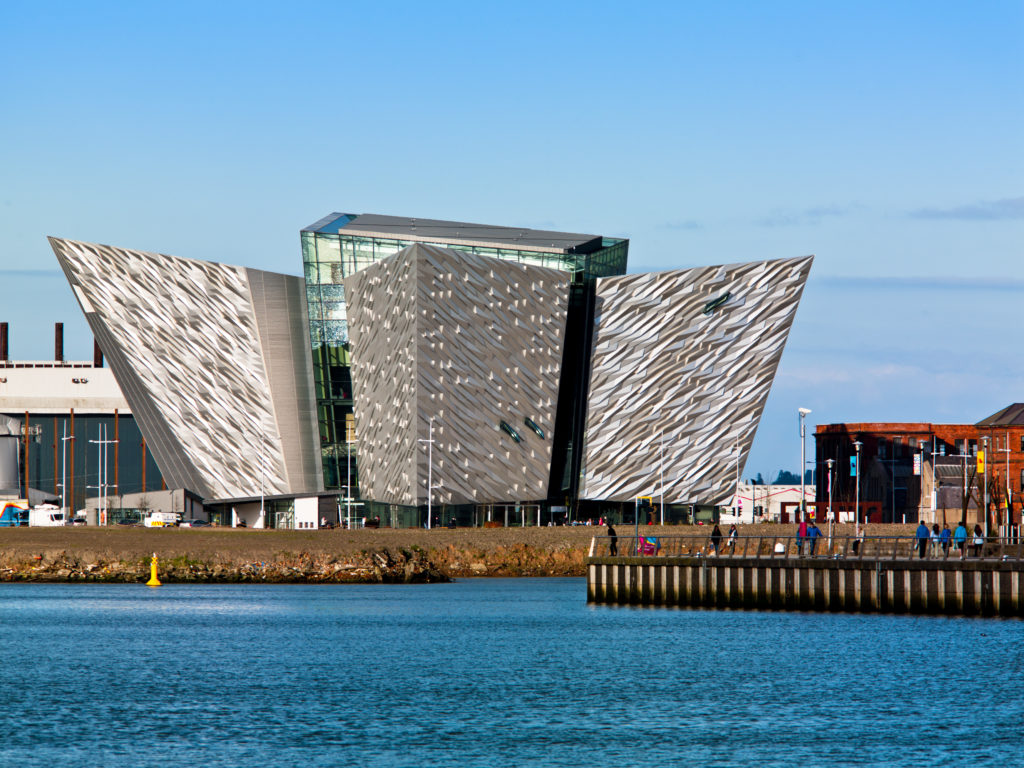THE novelist Owen Hannay wrote: "I was born in Belfast and brought up to believe that, like St. Paul, I am a citizen of no mean city."
Dark, dramatic, rollicking Belfast remains today, no mean city.
Despite a past for which the kindest word would be ‘eventful’, today it’s a friendly, welcoming place.
Titanic Belfast
In a city where architectural extravagance is scarce, this building truly stands out. Opened in 2012, it stands in the shadow of the Harland and Wolff shipyard cranes.
The museum is composed of nine interactive galleries that explore the history of the Titanic, from its conception, design and construction in Belfast to its appointment with fate 1912.
The exhibition covers broader themes of maritime history, shipbuilding, and the people involved in Titanic’s story — including engineers, crew and passnegers, some of whom were emigrants seeking a better life in the New World.. Visitors can explore the sights, sounds, and even smells of the shipyard, with multimedia displays and recreations of key areas like the ship’s grand staircase.
The Ulster Museum in the University Quarter also has a comprehensive lowdown on the most famous ship since Noah’s Ark, as does the Ulster Transport Museum in Cultra, just outside Belfast.
 The Titanic Belfast (pic: Chris Hill)
The Titanic Belfast (pic: Chris Hill)The Ulster Museum
The Ulster Museum is stuffed full of swag, both expected and surprising: Viking artefacts, treasure from the Spanish Armada which foundered off the Antrim coast, and exhibits from the full sweep of the history of Ireland are all present and correct.
You’ll also get the lowdown on linen, rope and glass manufacturing, industrial machines and Irish painting. As they like to say at museums — the knowledge is free; you just have to bring a container to take it away in.
But it’s not all local stuff, not all Celts and Calvinists, nor just Titanic (in case you’d missed it, The Titanic was built in Belfast.).
The Ulster Museum is also home to what generations of Belfast people have called “the City’s Oldest Bleached Blonde". Princess Takabuti is 2,600 years old — an Egyptian mummy complete with teeth, skin and hair, plus a ghostly grin, and chemically-discoloured hair.
It now transpires that the woman may have died in a knife attack. This conclusion comes from recent state-of-the-art testing. It appears Takabuti was killed by being stabbed in the back. Not only that, but DNA tests have revealed she is more genetically similar to Europeans than modern Egyptians.
But why was she stabbed on the back? It seems unlikely we’ll ever know. Pop along yourself and see if you can throw some light on it.
Further Egyptian ruminations are provided by J Arthur Rank, an upstanding, God-fearing, Sunday School teacher who basically founded the British film industry. He regarded Cleopatra’s Needle as the finest landmark in London — on the grounds that it was the only London construction Jesus had ever clapped eyes on. The Needle is a genuine ancient Egyptian obelisk, built in Heliopolis around 1450 BC. So Jesus could indeed have seen the obelisk when he visited Egypt. So too could have Belfast’s Bleached Blonde — although she would have been and gone long before the big story from the Middle East emerged.
The restaurants
SOME years ago restaurant critic Clement Freud, on a trip to Belfast, was much taken by a sign in a pub reading: "Pint, pie and a kind word – a fiver."
Clement was duly served an immaculate pint of stout and a serviceable enough looking meat pie; but the chat didn't seem too forthcoming. "Hey! What about the kind word?” he enquired. The barman came back, leaned over the bar, and conspiratorially whispered, in a strong Belfast accent: "If I were yew, my friend, I wouldnae bother eatin' the pie."
A very unlikely scenario today. Belfast, like the rest of Ireland, has undergone something of a culinary revolution.
The city’s top tables include:
The restaurant
The Michelin-starred Muddler’s Club, tucked away on Waring Street in the Cathedral Quarter, is a buzzy restaurant in Belfast’s oldest area. The kitchen area is in full view of the diners, with the staff calm and relaxed. If your experience of kitchens is culled from the tv series Boiling Point or the comparable US series The Bear, The Muddler’s will come as something of a surprise. It seems that the kitchen staff don’t have to swear and shout, “Oui chef, non chef, and please don’t hit me with that leg of mutton, chef”, in order to produce cutting edge, mouth-watering cuisine.
The wait staff are friendly and knowledgeable to a fault. They will guide you through a seasonal tasting menu where you’ll encounter dishes such Wicklow venison with parsnip and chestnuts, or white onion soup with smoked haddock and curry oil.
https://themuddlersclubbelfast.com/
 A view across Belfast (Pic: Christopher Heaney)
A view across Belfast (Pic: Christopher Heaney)Belfast’s pubs
WHITE’S is Belfast’s oldest pub (one of several, as it happens). Yet when the barman tells you they received their first liquor licence in 1630, “the year before work on the Taj Mahal began”, you’re inclined to believe him.
At Holohan’s on Lanyon Place you’ll be provided with an excellent vantage point to gaze out on the River Lagan. Watching the great cranes that line the former shipyards, it’s easy to imagine the Titanic slipping anchor and sailing out into the Irish Sea, never to return.
Kelly’s Cellars, like White’s, is one of Belfast’s oldest pubs, a frequent meeting place for the United Irishmen in the run-up to the 1798 rebellion. As a not-qualified-at-all historian, I think I’m right in saying that Henry Joy, on the lam from English soldiers, hid behind the bar in this very establishment.
The pub was founded in 1720 — and 300 years after opening for business Kelly's manages to be a cross between everyman drinking pub, political meeting place and historic museum. Traditional music at the weekend too — Belfast is an epicentre of exceptional seisúns. This is the ideal place to meet Belfast people — even if you aren’t planning a rebellion.
The John Hewitt Bar is a handsome, convivial boozer opened in 1999. The menu is populist, but founded on sound local ingredients and delivered by a kitchen that can clearly cook.
The John Hewitt carries beers from Lisburn's Hilden Brewery.
www.visitbelfast.com
ireland.com
Go to jail after passing go
AT one time, the majority of people entering Belfast’s main prison had one thought — getting out of there as soon as possible, and using any means at hand. Now you can have a tour of the decommissioned HM Prison Belfast — aka Crumlin Road Gaol — enjoy a meal at the niftily named Cuffs, or have a dram at the Crum, courtesy of JJ McConnell’s Distillery in the old A-Wing.
Known by inmates, judiciary and security forces alike as the Crum, this Victorian-era prison closed for ordinary business in 1996. But during its century-and-a-half of service, it was a busy place, housing rebels, political prisoners and what became known by the prison service as ODCs (Ordinary Decent Criminals).
Built during the Great Famine times, the Crum has housed over 25,000 inmates, including high profile inmates such as Éamon de Valera, Martin McGuinness and Bobby Sands.
Today’s visitor experience includes a look at the gallows and the condemned cell: the site of the last judicial hanging on the island of Ireland, in 1961.
The Distillery
JJ McConnell’s whiskey distillery and bar in the old A-Wing of Crumlin Gaol will give you the whole lowdown in whiskey — and they know what they’re talking about: the brand began in Belfast in 1776. You’ll learn about the distilling process and of course, taste a spot of the cratur along the way;
McConnell’s Distillery has an all-day café, plus a fully licensed bar to enjoy after the tour.
You can even host your own event here; I imagine organising a do in a distillery is on a par with curating a night of inebriation at a brewery. So, good luck!

